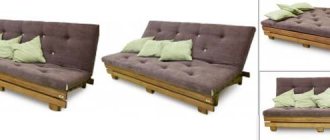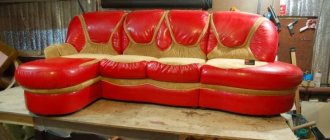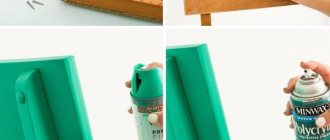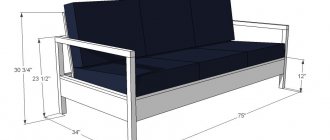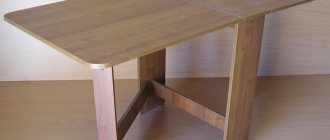Pros of furniture repair
- A good frame gives great advantages in the possibility of restoration. Moreover, old furniture is more reliable and durable.
- The choice of sheathing material is up to the owner;
- Self-restoration of furniture involves the possibility of repairing the frame of a sofa or chair;
- Soviet sofas are more durable and wear-resistant compared to modern upholstered furniture;
- Self-repairs do not require large financial expenditures, which will significantly save the family budget;
- Furniture upholstered with your own hands is unique and inimitable.
Types of filler
The variety of fillers is not inferior to the options for choosing fabric. Manufacturers offer synthetic winterizer, polyurethane foam, felt, struttofiber and foam rubber.
Synthetic winterizer is used in combination with other types of fillers. This is due to the low density coefficient. Rarely used as a main filler due to rapid pressing. Manufacturers recommend filling pillows with padding polyester.
Polyurethane foam is a modern filler represented by foamed material with varying degrees of porosity. Used as anatomically adjustable materials. Cheap analogues sag over time and lose their original shape.
Felt is not used as a base filler. Ideal in combination with other types of fillers. The naturalness of the material provides hypoallergenic and thermoregulatory properties. Disadvantages include the likelihood of mold development and the breeding of insects if used improperly.
Struttofiber is an analogue of polyurethane foam. It is distinguished by a high degree of anatomical adaptability to the human body due to non-woven independent springs. Struttofiber has a high percentage of aeration, is hypoallergenic and does not absorb liquid.
We recommend reading:
DIY table: review of the finished drawing, assembly diagram, choice of material and dimensions (98 photo ideas)
- Do-it-yourself upholstery (upholstery) of chairs: 100 photos of ready-made options and unusual designs
- Do-it-yourself furniture decoupage: review of the best techniques, original ideas and beautiful design (140 photos)
Foam rubber is the most affordable filler option. The disadvantages are a short shelf life, so foam rubber is recommended to be used as a filler for sofas, in particular armrests.
Features of choosing foam rubber
The foam sheet is selected mainly based on two indicators: thickness and density. The layer thickness should be at least 4 cm, and the density should be about 30 kg/m3. The service life of the new filler and its performance depend on these indicators. A thinner and softer one will be easily pressed through and will soon require replacement again, while one that is too dense will make the seat uncomfortably hard.
Therefore, when deciding which foam rubber to choose, pay attention to its brand: the first numbers in it indicate the density, and the last ones indicate the stiffness index. The service life of the furniture and the cost of the filler will depend on these indicators. When you come to the store to choose foam rubber for the sofa, do not hesitate to touch each sample and squeeze it in your hands. This will help you determine the difference in stiffness levels and choose the ideal option for you.
How to calculate the required amount of material
Reupholstering upholstered furniture at home is a complex and time-consuming process. In order not to have to sew individual flaps on a sewing machine, you need to take into account the size of the roll of selected fabric. When calculating the required footage, you need to remember the possibility of fabric overlaps. On average, up to 30 cm is taken into account.
Masters advise taking into account two lengths and two widths of the sofa. With this approach there will be no difficulties with calculations.
The decisive aspect is the print of the selected fabric. Drawings and patterns are adjusted to each other and this will require extra meters of fabric.
Rules for working with leather
Leather is a very difficult material to work with. Not every craftsman can reupholster furniture using it. To succeed in this matter, you need to adhere to certain recommendations:
- It is better to cut the skin only in cross section. When cutting paired parts in different directions, one will stretch more than the other.
- You should not prick the material with pins, because this will leave visible marks that cannot be removed.
- For sewing thin leather, a regular needle No. 80 or No. 90 is recommended. For thick leather, you should choose a special two-edged or tetrahedral tool. This tip shape allows you to easily pierce rough materials, leaving minimal marks, preventing skipping. The stitch length must be set close to the maximum, otherwise the leather may tear.
- To sew, you need an industrial sewing machine. Otherwise, not only the needle will break, but also the equipment itself. Before using it, you should carefully read the instructions to find out whether it is capable of sewing leather.
- You can only cut with a stationery knife. First you need to lay down a plastic or wooden board.
- There are special feet for sewing leather. Instead of a flat sole, they have a Teflon roller installed, which removes the resistance from the sewing foot without weakening the effort to press the material.
- It is important to pay attention to the pile when sewing suede leather, as pieces joined in opposite directions will be different colors.
For sewing, it is better to use a special reinforced thread, matched to the color of the material; simple threads will not work.
If you adhere to the rules and observe the order of work during restoration, then your favorite furniture will be able to last for a very long time, delighting you with its updated appearance. In addition, this will save a lot of money. It is also important that any person has the opportunity to show their imagination and use their favorite materials for work.
Instructions for using "Vanisha" for cleaning upholstered furniture for housewives
For cutting, use a stationery knife
To sew you need an industrial sewing machine
It is better to cut the skin only in cross section
How to remove old upholstery
It is recommended to carefully cut off the old upholstery using a utility knife in order to later measure out new pieces of fabric using it. The security of fastening with building staples complicates the task, so if necessary, the upholstery is removed and the old staples are driven into the wood. The process of removing upholstery is long and labor-intensive, sometimes difficult even for experienced specialists.
After removing the upholstery, it is recommended to remove the filling and properly dispose of it. It is not worth saving on filler, because mold and dust mites develop in it.
To avoid unexpected damage, furniture is disassembled into its components and carefully inspected for defects. If present, the part is replaced. Metal joints are treated with silicone to prevent corrosion and squeaks.
Required Tools
We have chosen the fabric - it must be taken with a margin for the possibility of error, now we will prepare the tools that will be needed: a sewing machine, a set of needles, strong threads (polyester), a flat-head screwdriver, a hammer, an anti-stapler to remove old staples, pliers, wrenches (from 8 up to 19 mm), side cutters, furniture stapler, scissors, staples (6-8 mm), sewing meter, square, metal ruler, chalk, screwdriver, drill, glue.
The necessary set of tools.
How to cut material
Having prepared the furniture for the final stage, we begin cutting out the fabric.
To begin with, filler is sheathed on a wooden furniture frame using a furniture stapler. Two or more fillers are glued together with a special odorless glue.
To ensure a tight fit and reliability, the brackets are shot perpendicular to the beams. There is no need to skimp on braces. If the upholstery or filling comes off after reupholstering, they can be secured after re-disassembly.
There are two ways to cut the upholstery:
- Using old scraps of fabric;
- According to the size of the spilled filler.
The combination of the two methods will not allow you to make mistakes in cutting and adjusting the fabric. In order to eliminate the lack of fabric, it is necessary to add 2-4 cm from the edge as a reserve.
Useful tips for beginners
Before reupholstering, you should stretch the workpieces, carefully straighten them, so you can see all the shortcomings that need to be corrected. It is important that the location of the seams is correct and the edges are parallel to each other. When securing the upholstery, you need to hold the stapler in your right hand, and with your left hand, pull the fabric from the middle of the workpiece to its edge. The bevel should be even so that there is no excess fabric left.
All holes for bolts must be cut carefully with scissors, and not torn using fasteners. Staples that are not completely driven in need to be driven in harder with a hammer. It is better to assemble a sofa, armchair or other furniture after all the upholstery has been completely replaced; it is necessary to install structural elements in advance only if necessary.
Upholstering furniture with new fabric and replacing the filling is a simple process that requires care and attention. Any beginner can do the job; the main thing is the availability of tools, time, and the necessary material. Replacing old upholstery can be a fun family activity - the husband does the repair work, the wife does the cutting and sewing, and the kids do the reupholstery with their parents.
When reupholstering, it is important that the location of the seams is correct and the edges of the workpieces are parallel to each other
If some staples are not fully seated, they can be driven in with a hammer
It is better to assemble the furniture after all the upholstery has been completely replaced.
Sofa assembly
Restoring upholstered furniture is a reciprocal process, so the sofa is assembled in the reverse order - armrests, pillow and backrest. Before completing the cladding, it is worth checking the strength of the structure and the filler.
Photos of upholstered furniture after reupholstery leave rave reviews. Re-upholstering furniture yourself is difficult and problematic, but the result is worth it. This method of “reviving” old things saves the budget and allows us to preserve things that are dear to us. Upholstered furniture after repair looks like new from the store.
